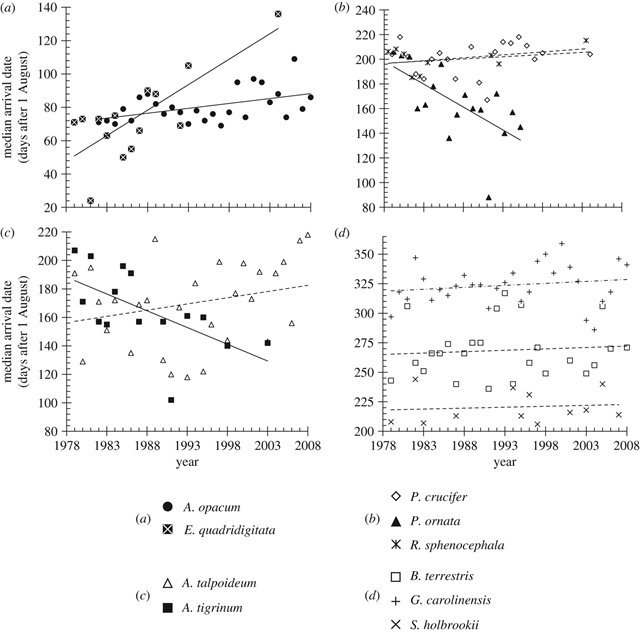Graph of the Day: Reproductive Timing of South Carolina Amphibians, 1978-2008
Median arrival dates of (a) autumn-breeding urodeles, (b) winter-breeding anurans, (c) winter-breeding urodeles and (d) spring-breeding anurans. Closed symbols with solid trend lines indicate significant shifts in breeding phenology at α = 0.05 level. Note that data points were offset in panel (b) for clarity. Climate change has had a significant impact globally on the timing of ecological events such as reproduction and migration in many species. Here, we examined the phenology of reproductive migrations in 10 amphibian species at a wetland in South Carolina, USA using a 30 year dataset. We show for the first time that two autumn-breeding amphibians are breeding increasingly later in recent years, coincident with an estimated 1.2°C increase in local overnight air temperatures during the September through February pre-breeding and breeding periods. Additionally, two winter-breeding species in the same community are breeding increasingly earlier. Four of the 10 species studied have shifted their reproductive timing an estimated 15.3 to 76.4 days in the past 30 years. This has resulted in rates of phenological change that range from 5.9 to 37.2 days per decade, providing examples of some of the greatest rates of changing phenology in ecological events reported to date. Owing to the opposing direction of the shifts in reproductive timing, our results suggest an alteration in the degree of temporal niche overlap experienced by amphibian larvae in this community. Reproductive timing can drive community dynamics in larval amphibians and our results identify an important pathway by which climate change may affect amphibian communities.
Todd, et al., Climate change correlates with rapid delays and advancements in reproductive timing in an amphibian community, December 15, 2010, Proc. R. Soc. B, doi: 10.1098/rspb.2010.1768
